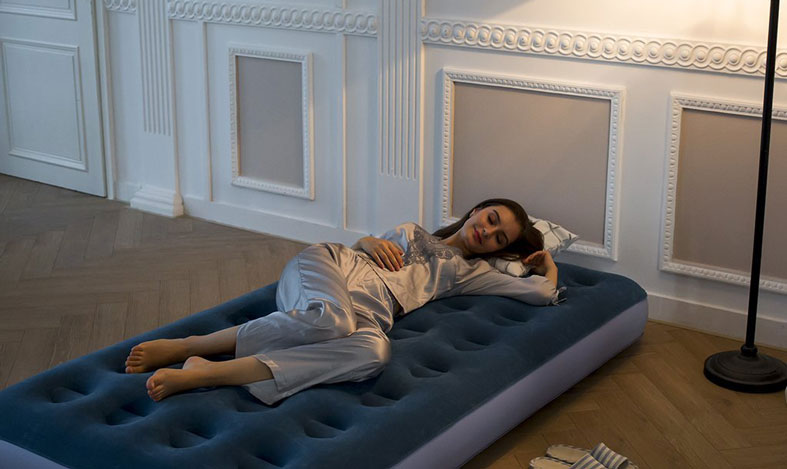Are inflatable beds just suitable for camping, or can they be used on a more long-term basis as well? Do they offer the kind of support that you need for a good night’s sleep? How long will they last?
You can save a bit of money by choosing an air mattress over a standard one, but is it a good idea to do so? In this article, we break down the benefits and negatives of sleeping on an inflatable mattress long-term.
We will look at the risks associated with using them in the long-term, how you can make them more comfortable and more like “real” beds, how to take care of them and how to choose the right model.
Will “real” beds win out in the end or can the air mattress be a real contender? Let’s go and find out.
5 Risks of Sleeping on an Inflatable Bed Long Term
Temperature Regulation
One of the issues when it comes to using an air bed is that regulating your body temperature can be harder. Most of these mattresses are made from synthetic materials such as vinyl and so won’t breathe well.
Because of this, there is no way to disperse the heat your body generates throughout the night. The air trapped inside takes on the temperature outside. That could make for an uncomfortable and sweaty night’s sleep when temperatures are higher.
In winter, the air inside takes on the cooler temperature, and this could leave you feeling cold. The best way to combat either of these issues is to place enough of a barrier between you and the bed’s surface. This could be in the form of a couple of cotton sheets in summer or blankets or a mattress topper in winter.
Body Support
An inflatable mattress is not known for the support it provides. While it might be okay to sleep on once in a while, long-term use could lead to back pain and stiffness. Without adequate support, your spine will be out of alignment, and so you won’t have a restorative sleep.
Mattress Maintenance
Maintenance with a lot of mattresses is very low key. Your standard coil option, for example, just needs to be flipped every now and again to allow for more even wear and tear. This is not the case with the inflatable models.
You will have to make sure that it has enough air in it and that holes are patched up quickly. Even if there are no holes, they do flatten naturally over time and need refilling. This makes them a higher maintenance option.
Comfort Level
They are not all extremely comfortable to sleep on. Support levels, as mentioned above, might not very high leading to you battling to fall asleep and also not sleeping very comfortably. There is no deep contouring support and not much in the way of pressure relief either.
Sleeping With a Partner
If you are sleeping with someone else, one of the leading disadvantages is that there will be a lot of motion transfer. It is inevitable – every time you or your partner moves, the other person will be jolted. This can make it difficult to get an adequate night’s rest, especially if you’re a light sleeper.
How To Make It More Comfortable
Make It a “Real” Bed
One aspect that really makes a difference to sleep quality is quality bedlinen. If you have to use your air bed for a more extended period of time, give some thought to using bedding that has a luxurious feel.
Get the best sheets that you are able to afford and pillows and comforter. Spritz the sheets with linen spray before use to up the experience another notch.
Re-Inflate Regularly
Check your bed regularly for sagging and re-inflate it as often as needed. It is best to check every second or third day to make sure that it has enough air in it.
Store the pump close at hand so that you can pump it up when making the bed, if necessary.
Learn More: Why Do Air Mattresses Deflate?
Use a Mattress Topper
These can really make a lot of difference to your quality of sleep. It adds an extra layer of cushioning and support for you and can help with temperature regulation as well.
Choose a quality topper for the best results – even if you do change to a different type of bed you’ll still own the topper.
View Our Full Guide: Best Mattress Topper
Create a Headboard
A headboard is more than just an aesthetic feature in the bedroom. It will help to keep your cushions in place and give you something to lean against at night. The headboard would need to be positioned against a wall for support.
It is one of the easiest ways to create a more traditional feel.
Invest in a Mattress Stand or Cot
This is important to help keep out the cold in winter. The closer you are to the ground, the colder you will get so putting a barrier between your air bed and the floor can help to make you more comfortable.
It also helps to create a more traditional feel.
Choosing a Long-Term Inflatable Mattress
Comfort
Air mattress comfort should be one of the first things that you check. How comfortable is it going to be? Is it meant merely for camping or will it be plush enough to sleep on every night?
Some models will allow you to adjust the firmness to your liking and this can be a plus. Above all else, though, do look for something that offers better support.
Get More Info: How To Make An Air Mattress More Comfortable
Durability
You get what you pay for. If you walk into a discount store and buy the cheapest outfit you can find, you know that it is not going to last you a long time. The same applies in this case.
Buy the best quality air bed that you can afford. You are able to get some really cheap products out there, but these will cost you a lot more in the long-term.
Air Retention
If you choose a good quality product, you should be okay when it comes to air retention. While you are invariably going to have to top up the air from time to time, you don’t want to have to do this every day.
Find a quality option with good air retentive properties.
Material
Check out what it is made of. You want an option that has a nice quality foam layer that won’t deteriorate too quickly and a high-quality vinyl cover that will stand up well to wear and tear.
Many options have a softer suede-like finish that feels very nice to the touch, but it is the underlying foam that is really going to make the most difference. The cover is not as important because you will not be sleeping directly on it anyway.
Warranty
A good warranty is vital. You need to ensure that you will get your money back or get a replacement if something does go wrong. Start by looking at the manufacturer’s reputation and warranty policy.
A two- to three-year warranty against manufacturer’s defects should be your minimum starting point. Also look at long-term repair or replacement options.
Frequently Asked Questions
Q: How can I keep my blow-up bed from deflating?
A: By taking excellent care of it. Start by protecting it from sharp objects that create a puncture or tear. Check for such objects before inflating the bed.
You should also be careful not to overinflate it. Too much air can be worse than too little because it increases the chances of it popping when pressure is placed on it. Check it on a regular basis for holes. It doesn’t take long to check it for holes, and by doing so regularly, you will be able to patch them before they become too much of an issue.
Use the right bedding. Sheets protect the inflatable from dirt and grime and can also provide additional protection against sharp objects. A topper can be put in place to provide additional protection.
Need help? Learn how to fix an air mattress leak here.
Q: How long do inflatable beds last?
A: A quality bed that is looked after properly can last as long as ten to fifteen years. However, having said that, the National Sleep Foundation does recommend replacing your mattress every eight years or so.
If you are using the bed every day, this recommendation should be adhered to.
Q: Will it cause back pain?
A: Again, this is going to depend on the quality of the bed itself. Look for an option that has adjustable support so that you can choose the right firmness for your sleeping position.
If you are a side sleeper, you need something that has a little give in it so that you can sink deeper into it. If you prefer to sleep on your back or maybe the most comfortable way is to nap on your stomach, choose a firmer option.
Read More: Is Your Mattress Causing You Back Pain?
Conclusion
So, is an inflatable mattress the best option when it comes to long-term sleeping arrangements? This will depend on the option that you choose. While it is not ideal, it can be a viable option if you look for one that offers excellent support.
In this case, support is the factor that you need to consider first and foremost. Adjustable options are a good idea because you can then choose your own level of firmness.
They are not, however, essential. You can do a lot to make your air bed more comfortable and supportive – like choosing the right base, adding on a topper, and using the proper bedding.
A good air bed will be better for you in the long-term than a bed that is past its prime anyway. The key is to choose a good brand from a reputable manufacturer and to take proper care of it. If you approach choosing the right option carefully, this can be a satisfactory alternative for you.
Sources
Jill Zwarensteyn
Editor
About Author
Jill Zwarensteyn is the Editor for Sleep Advisor and a Certified Sleep Science Coach. She is enthusiastic about providing helpful and engaging information on all things sleep and wellness.
Combination Sleeper



